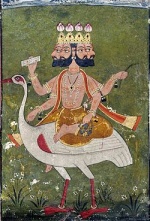Brahma
Brahma (devanāgarī: ब्रह्मा brahmā) is the Hindu god of creation and one of the Trimūrti, the others being Viṣṇu and Śiva. This Sanskrit word derives from the verbal root bṛh "to expand, grow, fructify", because "Brahma ‘expands’ and becomes the Universe woven out of his own substance".[1] Brahmā is a male creative principle which should not be confused with the neuter Brahman.
Theosophical view
In one of his letters, Mahatma M. says it is "the vivifying expansive force of nature in its eternal evolution".[2]
In The Theosophical Glossary H. P. Blavatsky says:
The student must distinguish between Brahma the neuter, and Brahmâ, the male creator of the Indian Pantheon. The former, Brahma or Brahman, is the impersonal, supreme and uncognizable Principle of the Universe from the essence of which all emanates, and into which all returns, which is incorporeal, immaterial, unborn, eternal, beginningless and endless. It is all-pervading, animating the highest god as well as the smallest mineral atom. Brahmâ on the other hand, the male and the alleged Creator, exists periodically in his manifestation only, and then again goes into pralaya, i.e., disappears and is annihilated.[3]
In Theosophical literature Brahmā is usually identified with the manifested Logos, which includes the whole universe:
Brahma — the symbol of the Universe. In esoteric parlance, Brahma is Father-Mother-Son, or Spirit, Soul and Body at once; each personage being symbolical of an attribute, and each attribute or quality being a graduated efflux of Divine Breath in its cyclic differentiation, involutionary and evolutionary. In the cosmicophysical sense, it is the Universe, the planetary chain and the earth; in the purely spiritual, the Unknown Deity, Planetary Spirit, and Man — the Son of the two, the creature of Spirit and Matter, and a manifestation of them in his periodical appearances on Earth during the “wheels,” or the Manvantaras.[4]
In Hinduism
Brahmā is the first member of the Hindu triad; the supreme spirit manifested as the active creator of the universe. He sprang from the mundane egg deposited by the supreme first cause, and is the Prajāpati, or Lord and father of all creatures, and in the first place of the Rishis or Prajāpatis.[5]
Brahmā is depicted as red in color, with four bearded faces and four arms, each holding a sacred object. His vāhana or vehicle on which he rides is a milk-white swan or goose, the Haṃsa.
In popular culture
Ralph Waldo Emerson named one of his most famous poems "Brahma." It was first published in The Atlantic in 1857.
- If the red slayer think he slays,
- Or if the slain think he is slain,
- They know not well the subtle ways
- I keep, and pass, and turn again.
Additional resources
- Brahmā in Theosophy World
- Brahmā Vach in Theosophy World
Notes
- ↑ Helena Petrovna Blavatsky, The Secret Doctrine, vol. 1 (London: The Theosohpical Publishing House, 1978), 83.
- ↑ Vicente Hao Chin, Jr., Mahatma Letters to A.P. Sinnett in Chronological Sequence, no. 44 (Quezon City: Theosophical Publishing House, 1993), 118.
- ↑ Helena Petrovna Blavatsky, Theosophical Glossary (Krotona, CA: Theosophical Publishing House, 1973), 62.
- ↑ Helena Petrovna Blavatsky, The Secret Doctrine vol. I, (Wheaton, IL: Theosophical Publishing House, 1993), 41.
- ↑ John Dowson, A Classical Dictionary of Hindu Mythology, (London, Routedge & Kegan Paul Ltd, 1968), 56.
